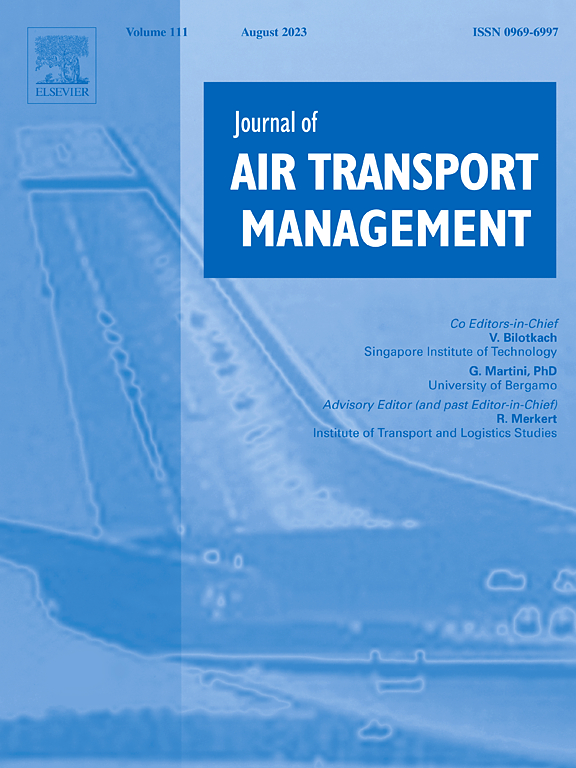利润效率:洞察航空公司的商业模式和战略选择
IF 3.6
2区 工程技术
Q2 TRANSPORTATION
引用次数: 0
摘要
在经历了21世纪充满挑战的开端之后,航空公司在经济大衰退(2007-2009)之后反弹,实现了创纪录的利润。盈利能力是指企业的绝对财务收益,而利润效率是衡量企业在其经营环境和投入价格的情况下,如何有效地将其资源转化为最大潜在利润。这些截然不同的经济概念提出了有关航空公司战略的关键问题:航空公司能否实现利润最大化?哪种商业模式的利润效率更高?影响他们利润效率的因素是什么?本研究使用基于2009年至2019年美国航空公司数据的随机利润效率模型来解决这些问题。我们的研究结果显示,美国航空业的平均利润效率为93.2%。低成本航空公司(lcc)的平均效率得分更高,为98.7%,而全服务航空公司(FSAs)的平均效率得分为95.3%。超低成本航空公司(ulcc)的利润效率最低,为86.1%。最后,低成本航空公司多年来表现出更稳定的利润效率。此外,辅助收入正向影响利润效率,表明附加定价导致更高的加价。经济大衰退后实施的运力约束和合并等战略显著提高了利润效率,而机场网络扩张则降低了利润效率。总体而言,本研究突出了美国航空业的利润效率程度,并确定了影响它的关键因素。本文章由计算机程序翻译,如有差异,请以英文原文为准。
Profit Efficiency: Insight into airline business models and strategic choices
Following a challenging start to the 21st century, airlines rebounded to achieve record profits in the aftermath of the Great Recession (2007–2009). While profitability refers to the absolute financial gains of a firm, profit efficiency is a measure of how effectively a firm converts its resources into maximum potential profit, given its operating environment and input prices. These distinct economic concepts raise key questions about airline strategies: Can airlines maximize their profits? Which business models achieve higher profit efficiency? What factors influence their profit efficiency? This study addresses these questions using a stochastic profit efficiency model based on data from U.S. airlines spanning from 2009 to 2019. Our findings reveal that the U.S. airline industry exhibits an average profit efficiency of 93.2 %. Low-Cost Carriers (LCCs) have a higher mean efficiency score of 98.7 % while Full-Service Airlines (FSAs) follow them with 95.3 %. Ultra-Low-Cost Carriers (ULCCs) have the lowest profit efficiency at 86.1 %. Finally, LCCs have demonstrated more stable profit efficiency over the years. In addition, ancillary revenues positively impact the profit efficiency, indicating higher markup resulting from add-on pricing. The strategies implemented after the Great Recession—such as capacity discipline and mergers—have significantly increased profit efficiency while the airport network expansion result in lower profit inefficiency. Overall, this study highlights the extent of profit efficiency for the U.S. airline industry and identifies the key factors influencing it.
求助全文
通过发布文献求助,成功后即可免费获取论文全文。
去求助
来源期刊

Journal of Air Transport Management
TRANSPORTATION-
CiteScore
12.40
自引率
11.70%
发文量
97
期刊介绍:
The Journal of Air Transport Management (JATM) sets out to address, through high quality research articles and authoritative commentary, the major economic, management and policy issues facing the air transport industry today. It offers practitioners and academics an international and dynamic forum for analysis and discussion of these issues, linking research and practice and stimulating interaction between the two. The refereed papers in the journal cover all the major sectors of the industry (airlines, airports, air traffic management) as well as related areas such as tourism management and logistics. Papers are blind reviewed, normally by two referees, chosen for their specialist knowledge. The journal provides independent, original and rigorous analysis in the areas of: • Policy, regulation and law • Strategy • Operations • Marketing • Economics and finance • Sustainability
 求助内容:
求助内容: 应助结果提醒方式:
应助结果提醒方式:


